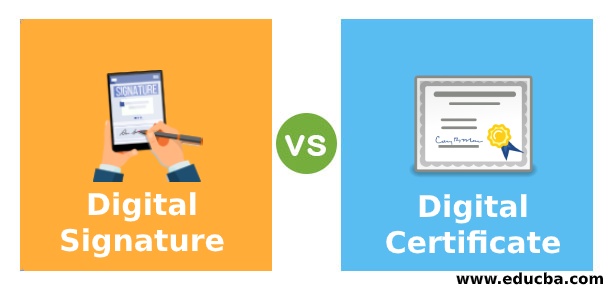Updated April 3, 2023

Difference Between Digital Signature vs Digital Certificate
The following article provides an outline on Digital Signature vs Digital Certificate. Both digital certificate and digital signature are a part of cryptography but their implementation and the purpose is different. We, the technical people just love this kind of jargon. So we just forgot that our words are overlapping and hence the confusion.
What is digital signature?
In day-to-day life, an organization or an entity in general terms produces a lot of digital data. That could be a word document, an image or anything in a digital form. However, how will we identify who the owner of that digital media is? Moreover, if someone has signed that document is he someone who he claims to be? How can you verify if the signature is forged? Here comes the digital signature. The digital signature is a method of verifying the authenticity of a transaction, document or a message. It guarantees that the message is generated by the sender and is not modified by the external entity. The digital signature is not the same as encryption but it works in conjunction with encryption. It falls into the category of hashing.
What is digital certificate?
Think of a digital certificate as an identification card just like a driving license or a passport. Digital certificates are issued by authorized third parties. If someone requests a digital certificate the authorized third party verifies the identity of the requestor and checks if the requester meets all the requirements to receive a certificate. When an end-user/customer presents this certificate he/she can verify the identity of its owner. The usage and the purpose of digital signature and digital certificate are different. But the end goal is the same for both of them which is providing security by protecting the data.
Head to Head Comparison Between Digital Signature vs Digital Certificate (Infographics)
Below are the top 10 differences between Digital Signature and Digital Certificate:
Key Difference Between Digital Signature vs Digital Certificate
Let us discuss some of the major key differences between Digital Signature and Digital Certificate:
- The digital signature is used to identify the owner of the document whereas the digital certificate is a document that identifies the identity of the organization.
- The digital signature is signed created by the signer’s private key and verified by the public key of a signer whereas digital certificate is issued by a third party and an end-user can check its validity and authenticity.
- The digital signature uses a mathematical function (Hashing function) wherein a Digital certificate contains personal information to help in identifying the trace of the owner.
- A digital signature is created using DSS (Digital Signature Standard) whereas digital certificate works on the principles of public-key cryptography standards.
- A digital signature uses the RSA algorithm when there is a need for message encryption whereas digital certificate is proof that the data transmission will be on the secured layer and in an encrypted way.
- Digital signatures are used to validate the sent data whereas digital certificates are used to validate the identity of the sender.
- With a digital certificate, an end user may have a relationship with the sender whereas in the digital certificate the end user trusts the third party and does not have a relationship with the business owner or the entity.
Digital Signature vs Digital Certificate Comparison Table
Let’s discuss the top comparison between Digital Signature vs Digital Certificate:
| Digital Signature | Digital Certificate |
| It verifies the identity of the document. | It verifies the identity of the ownership of an online medium. |
| It is issued to a specific individual by an authorized agency. | It is issued after the background check of the applicant by the Certificate Authority(CA). |
| It ensures that the signer cannot non-repudiate the signed document. | It ensures that two parties who are exchanging the information are secured. |
| It works on DSS (Digital Signature Standard) | It works on the principles of public-key cryptography standards. |
| The digital signature uses a mathematical function (Hashing function). | It contains personal information to help in identifying the trace of the owner. |
| It is widely used for avoiding forging the document. | It is used in an online transaction for the trustworthiness of the data and the sender. |
| It is an attachment to a document that can be viewed as a signature. | It is a medium to prove the holder’s identity for a particular transaction. |
| It ensures the sender and the receiver have the same document containing the same data. | It builds the trust between the user and the business (Certificate holder). |
| It is created using SHA-1 or SHA-2 algorithms. | It is created in the X.509 format. |
| It uses the RSA algorithm if there is a need for message encryption. | It encrypts that data and only the receiver can decrypt it. |
Conclusion
Both the digital certificate and the digital signature are an integral part of security. We use them both in our day to day life. So next time you visit a website don’t forget to check whether it is has a valid digital certificate or not.
Recommended Articles
This is a guide to Digital Signature vs Digital Certificate. Here we discuss the key differences with infographics and comparison table. You may also have a look at the following articles to learn more –


